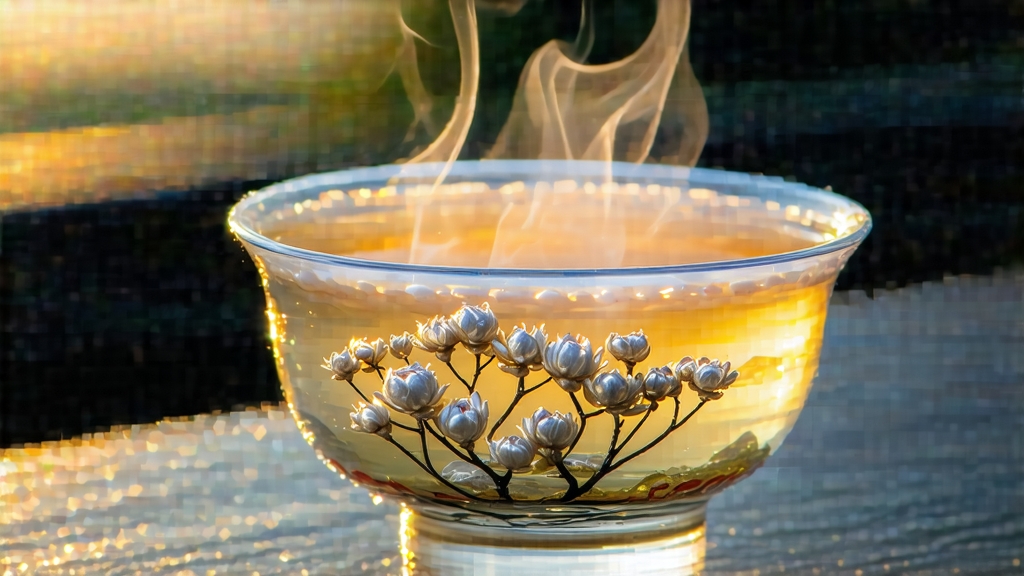
Among the six great families of Chinese tea, white tea is the least theatrical yet the most elusive. It is not rolled, not roasted, not kneaded into dramatic shapes; instead it is simply allowed to be. Of its three traditional grades—Silver Needle, White Peony, and Shou Mei—Silver Needle (Bai Hao Yin Zhen) stands at the apex: a tea made entirely of unopened buds, each one a silvery spearhead that looks as if it has been dipped in moonlight. To understand Silver Needle is to understand how Chinese artisans transformed restraint into refinement, and how a leaf that is barely processed can still speak vividly of place, season, and time.
Historical whispers
The written record of “white tea” first surfaces in the Song dynasty (960-1279), when the imperial court levied compressed cakes of lightly withered leaf as tribute. Yet those cakes were not the loose, fluffy Silver Needle we know today; they were dark, brick-shaped, and steamed for easier transport along the Grand Canal. The modern, bud-only style emerged during the late Qing in Fujian’s Tai Lao mountains, where small-holders discovered that the local Da Bai (Big White) cultivar produced buds so plump and downy that any manipulation beyond gentle air-drying felt sacrilegious. By 1796 the style was sufficiently celebrated to enter the imperial tribute list again, this time as loose, needle-shaped buds shipped from the county now known as Fuding. Foreign merchants stationed in Fuzhou snapped up the novelty, and by the 1890s Silver Needle was appearing in London auction catalogues beside Keemun and Lapsang, though always in tiny lots that fetched prices higher than first-flush Darjeeling.
Terroir and cultivar
Authentic Silver Needle is tethered to two micro-regions: Fuding in northeastern Fujian and Zhenghe in the interior mountains. Fuding’s coastal air is saline and breezy, encouraging slow transpiration and a lilting, orchid-like aroma. Zhenghe sits higher and cooler, giving teas with a deeper, honeyed bass note. Both areas grow variants of Camellia sinensis var. sinensis dubbed Da Bai Hao (Big White Hair) and, more recently, the even larger-budded Da Hao. The bushes are allowed to grow into waist-high shrubs rather than the tabletop hedges seen in Japanese gardens; this increases the ratio of bud to leaf and concentrates amino acids that later translate into sweetness.
Plucking etiquette
The picking window is brutally short: only the two or three days before Qingming (early April) when the buds have reached 2.5–3 cm but have not yet unfurled. Experienced pickers use a “twist-and-lift” motion that severs the bud cleanly without squeezing sap onto the down, which would oxidise into rust-coloured blemishes. A skilled worker gathers barely 500 g of fresh buds per hour; 30 000 buds—enough to fill a single 500 g tin—represent one person’s entire dawn-to-dusk effort.
Withering: the art of doing almost nothing
Once back at the farmhouse, the buds are spread in single layers on bamboo trays woven from strips no wider than a chopstick. The first four hours are spent outdoors under early-spring sun, the trays angled so that each needle receives oblique light rather than direct noon glare. When the bud surface turns matte and the moisture drops to roughly 40 %, the trays are moved indoors to a loft whose walls are made of woven reed mats. Here the tea “rests” for 24–36 h while the ambient humidity hovers around 65 %. No fans, no heaters: only the slow dialogue between leaf and air. Enzymes nibble at polyphenols, converting catechins into delicate theaflavins; starches unravel into simple sugars; grassy hexenals volatilise, leaving behind a scent that Chinese poets liken to “morning milk spilt on marble.” The moment the bud stem snaps cleanly when bent, withering is judged complete. A final half-hour of gentle breeze—often from a charcoal-heated pit whose smoke never touches the leaf—drops the moisture to 8–9 %, low enough for stable storage yet high enough to preserve a supple mouthfeel.
No rolling, no fixing, no baking
Unlike green tea, Silver Needor is never pan-fired; unlike oolong, it is never bruised;